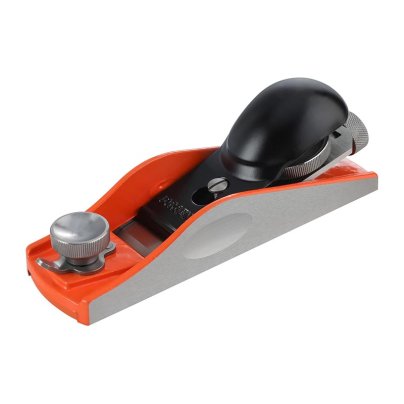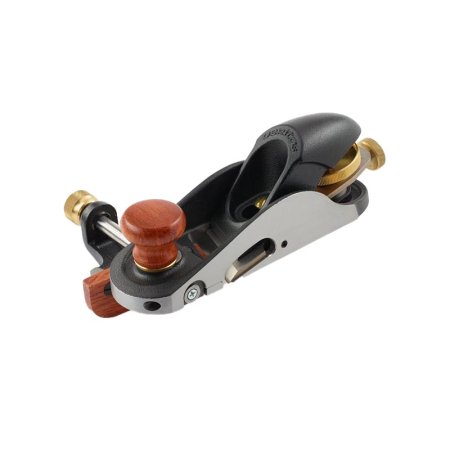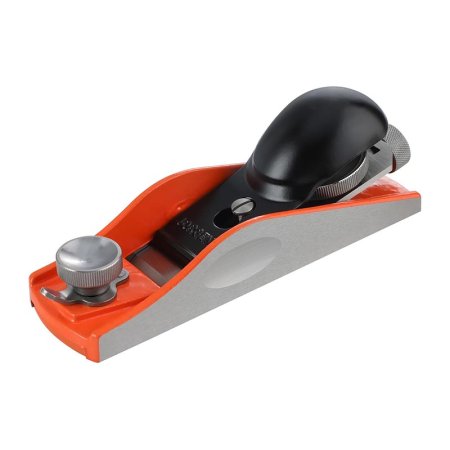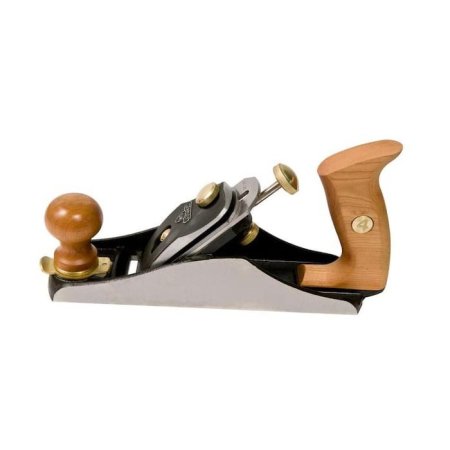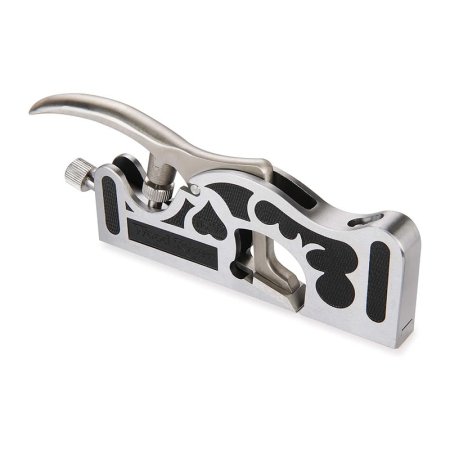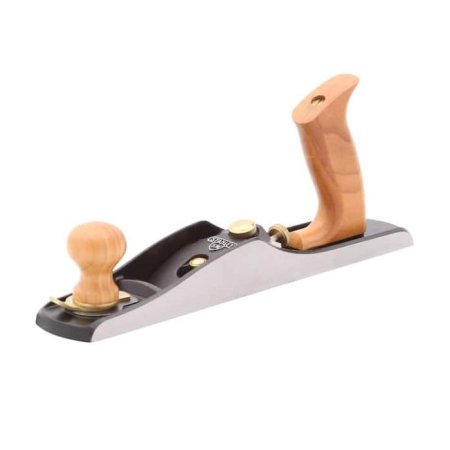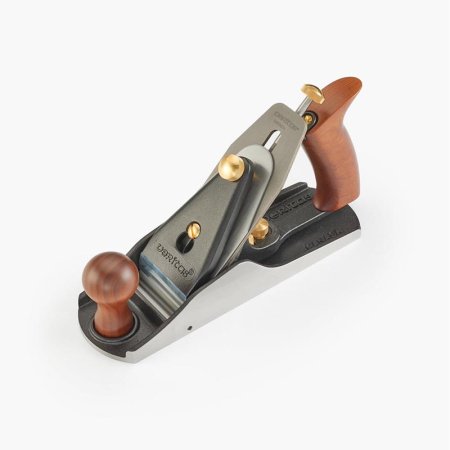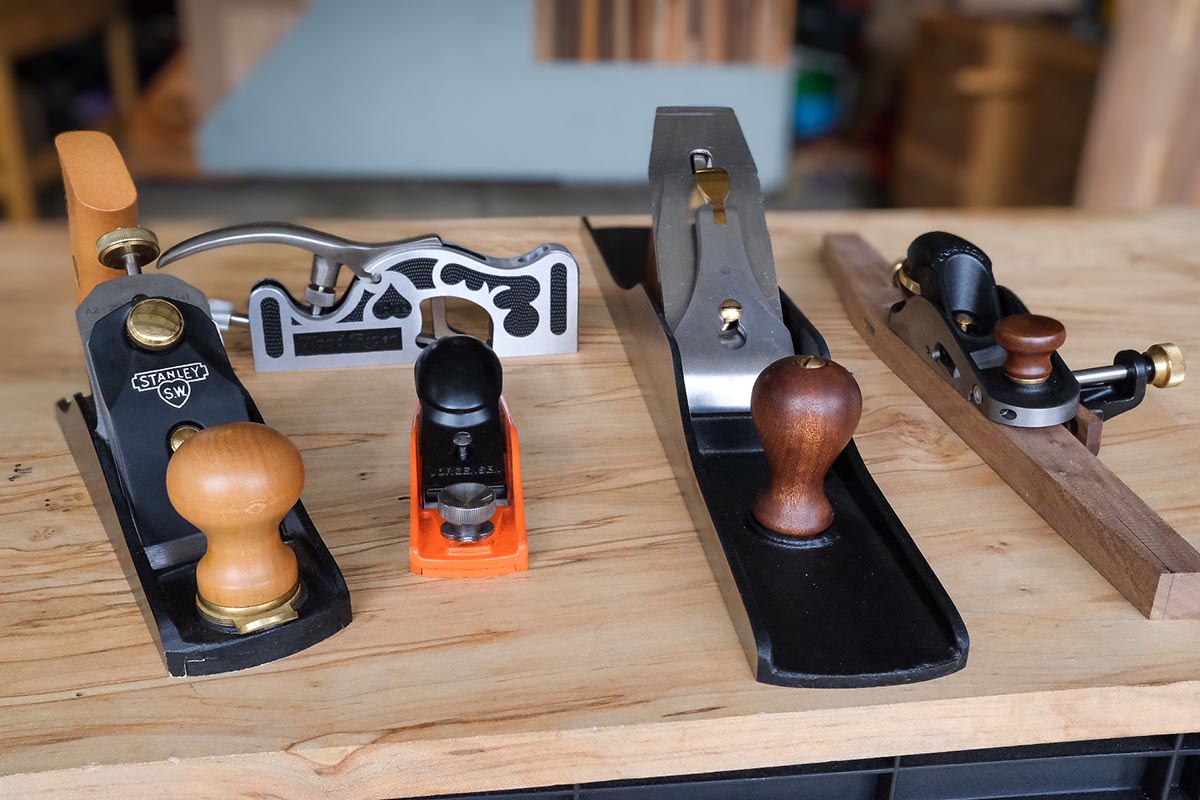
We may earn revenue from the products available on this page and participate in affiliate programs. Learn More ›
For practical home improvement tasks like shaving down a wood door that’s sticking or for woodworking projects like smoothing the surface of a wavy board, no tool works quite as well as a hand plane. Although it’s been a woodworker’s mainstay for centuries, this simple tool still has a place in today’s wood shop. That’s why we have tested 12 hand models over the past few years.
Our favorite, thanks to its versatility and superior build quality, is the Veritas Skew Block Plane, which combines the best features of a low-angle block plane with a skew rabbet plane.
However, the Veritas isn’t the only model that excelled in testing. Each of these hand planes performed exceptionally, earning a well-deserved place on our list.
However, the right tool for you depends on your projects. Most handheld wood planers are similar in shape, but they come in a host of sizes and types, and each type performs slightly different tasks, so it’s essential to know what to look for when choosing one. Read on to learn more about our top picks and discover what to consider when choosing the best hand plane.
- BEST OVERALL: Veritas Skew Block Plane
↓ Jump to Review - BEST BANG FOR THE BUCK: Pony Jorgensen No. 60½ Low-Angle Block Plane
↓ Jump to Review - BEST SMOOTHING PLANE: Stanley SweetHeart No. 4 Smoothing Bench Plane
↓ Jump to Review - BEST PRECISION PLANE: WoodRiver #92 Medium Shoulder Plane
↓ Jump to Review - BEST FOR FLATTENING BY HAND: Grizzly T33285 Premium No. 7 Jointer Plane
↓ Jump to Review - BEST FOR ROUGH LUMBER: Stanley No. 62 SweetHeart Low-Angle Jack Plane
↓ Jump to Review - BEST SPLURGE: Veritas #4½ Smoothing Plane
↓ Jump to Review
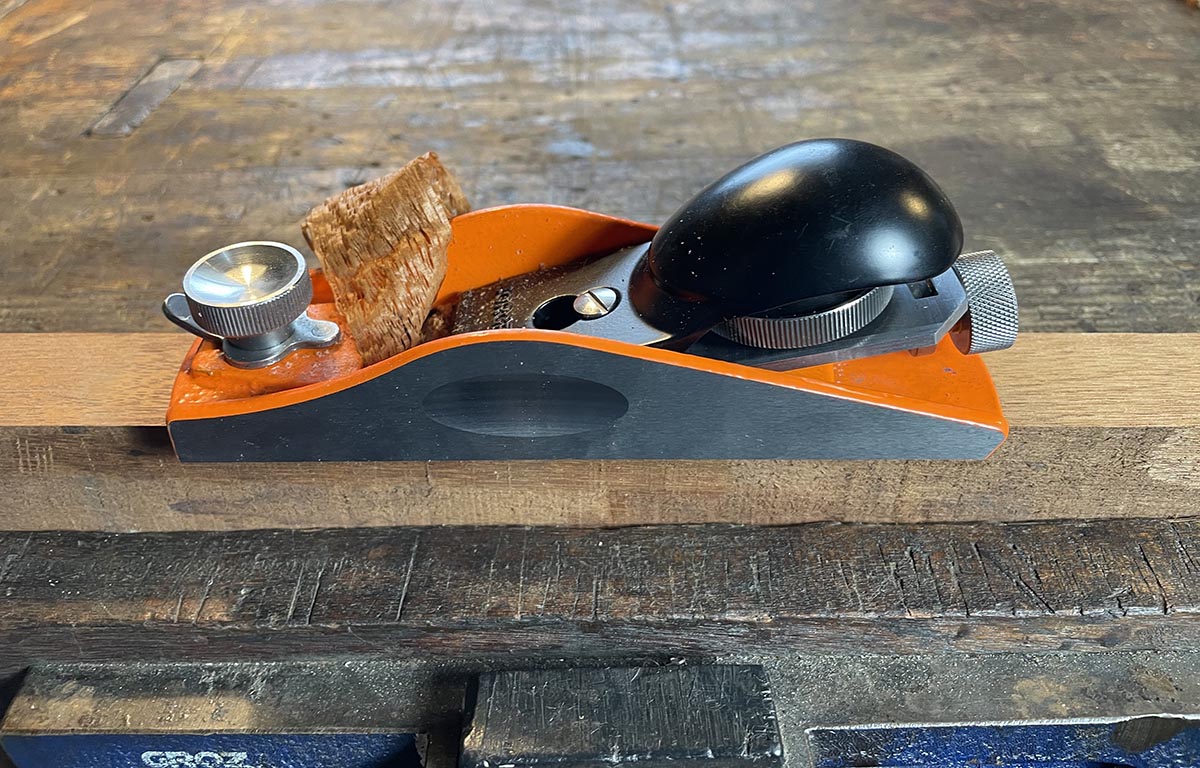
Hand Plane Comparison Chart
| Body Material | Dimensions | Blade Material | |
| Veritas Skew Block Plane | Ductile cast iron | 6⅜ inches by 1¾ inches | Choice of A2, O1, or PM-V11 tool steel |
| Pony Jorgensen No. 60½ Low-Angle Block Plane | Ductile iron body | 6¼ inches by 1¾ inches | O1 tool steel |
| Stanley SweetHeart No. 4 Smoothing Bench Plane | Not listed | 10⅝ inches by 2½ inches | A2 tool steel |
| WoodRiver #92 Medium Shoulder Plane | Ductile steel | 8 13/16 inches by ¾ inch by 3¼ inches | Mn65 tool steel |
| Grizzly T33285 Premium No. 7 Jointer Plane | Cast iron | 22 inches x 2⅜ inches | O1 steel |
| Stanley No. 62 SweetHeart Low-Angle Jack Plane | Cast iron | 15.8 inches by 6.7 inches | A2 steel |
| Veritas #4½ Smoothing Plane | Ductile cast iron | 10 inches by 2⅞ inches | Choice of A2, O1 or PM-V11 tool steel |
Our Top Picks
Whether you’re crafting fine furniture or building cabinets, these carefully selected hand planes will help you achieve professional results and elevate the quality of your work.
Best Overall
Veritas Skew Block Plane
What We Like
- Precision machining
- Norris-style adjuster offers micro-adjustability
- Scoring spur helps with cross-grain tear-out
- Fully enclosed moveable front toe
What We Don’t Like
- Needs specialized honing guide to sharpen skew blade
Specs
- Body Material: Ductile cast iron
- Dimensions: 6⅜ inches long by 1¾ inches wide
- Blade Material: Choice of A2, O1 or PM-V11 tool steel
Our Ratings: Build Quality 5/5; Ease of Use 4.8/5; Performance 5/5; Value 5/5
A cross between a block plane and a rabbet plane, the Veritas Skew Block Plane has a low bedding angle combined with a 15-degree skewed blade and an adjustable fence, so it can be used for tasks not possible with a regular block plane like fitting joints, cutting light-to-medium rabbets, and fielding raised panels (cutting rabbets around the edges of a raised cabinet panel).
The most versatile plane we tried, it cuts very well on end and cross grain thanks to the retractable scoring blade and easily cleans up dadoes and tenon cheeks. We also used it as a regular block plane to round over corners and shoot small pieces.
This Veritas plane is superb all around—from the stringent manufacturing tolerances to the ergonomics of the plane. The plane body is solid but not too heavy, and the Norris-style adjuster makes it easy to dial in exactly the right cut every time. Places that are supposed to be flat, like the sole, are. After weeks of use, the ⅛-inch thick blade held its edge beautifully. In terms of build quality, the Veritas skew block plane checks all the right boxes.
The only drawback we could find is that a skewed blade can be tough to sharpen for those not skilled at freehand sharpening. It takes some practice to maintain a consistent bevel and avoid altering the skew angle. Those who don’t work freehand should consider the Veritas Mk.II Honing Guide, which can help lock in the skew angle easily.
What our tester says: “This plane has proven itself indispensable in my workshop, particularly when working on complex joinery like trimming tenons or cleaning up rabbets. Its adjustable fence makes it a versatile tool for many tasks.” —Cathy Harms, Product Reviews tester and writer
Get the Veritas Skew Block Plane at Lee Valley.
Best Bang for the Buck
Pony Jorgensen No. 60½ Low-Angle Block Plane
What We Like
- Good performance at an affordable price point
- Easy-to-use blade and mouth adjustments for quick tuning
- Ergonomic design offers a comfortable grip
- Adjustable mouth reduces tear-out
- Setting blade depth is straightforward
What We Don’t Like
- Sole needs flattening and tuning before use
Specs
- Body Material: Ductile cast iron
- Dimensions: 6¼ inches long by 1¾ inches wide
- Blade Material: O1 tool steel
Our Ratings: Build Quality 4/5; Ease of Use 4.3/5; Performance 4.5/5; Value 4.8/5
The block plane is one of the handiest tools we tried. It can be used to chamfer edges, smooth end grain, flush a joint, and shoot end grain, but it’s cheap enough that users won’t have a heart attack if they drop it.
The Jorgensen plane’s ductile iron body interior is finished in bright orange and weighs 1.48 pounds with a ⅛-inch thick blade made of O1 tool steel. Its ergonomic design ensures a good fit in hand, and the edges are smooth. A slight recess near the front allows for a thumb rest, improving control while pushing the plane forward.
For the initial use, this plane’s sole needed to be flattened and polished. We noticed a low point near the adjustable mouth, but it only took about 2 minutes to flatten the sole. We noticed minor blade shifting during aggressive cuts but found that tightening and rechecking the lever cap can mitigate this.
The adjustable throat is a nice feature. It adjusts easily—just loosen the locking screw, adjust the level, and tighten the screw. We did have an issue with the throat plate not adjusting to 90 degrees, however, so we’d recommend double-checking for square after adjustments.
Finally, the chip breaker was machined well with a tight fit against the back of the blade with no light coming through. For those looking for solid performance on a budget, the Pony Jorgensen is one to consider. Just expect to have to tune it before initial use.
Get the Pony Jorgensen hand plane at Amazon and Lowe’s.
Best Smoothing Plane
Stanley SweetHeart No. 4 Bench Plane
What We Like
- Frog and base cast as one piece for more stability
- Throat opening is easy to adjust
- Extra thick ⅛-inch A2 tool steel blade maintains sharpness
- Superb out of box performance
What We Don’t Like
- Lateral adjustment mechanism is fussy
Specs
- Body Material: Not listed
- Dimensions: 10⅝ inches long by 2½ inches wide
- Blade Material: A2 tool steel
Our Ratings: Build Quality 4/5; Ease of Use 4/5; Performance 4.5/5; Value 4.3/5
The Stanley Sweetheart bench plane is solid, made of ductile cast iron, and has some heft to it, which we consider a positive attribute. The frog and base are cast as one piece giving this plane more stability and virtually eliminating chatter. The sole arrived flat and the sides square to the bed. The edges of the sole were sharp and needed to be slightly beveled, a minor inconvenience. In testing, the bench plane was a pleasure to use, leaving a pristine finish on scrap pine. We also tested it on walnut and white oak boards with excellent results.
The thick ⅛-inch thick blade is made of A2 tool steel and holds an edge well. The back of the blade was surprisingly flat out of the box and just needed to be polished. The blade was quite sharp with a 25-degree angle but adding a five-degree micro bevel allowed for a razor-sharp finish and smooth, consistent shavings.
While the throat opening is easy to adjust, we rate this plane’s ease of use only as slightly above average due to the fussy lateral adjustment mechanism. Our first couple of attempts resulted in the adjustment lock knocking the blade out of alignment when tightened. After trial and error, we found a way to tune the lateral adjustment so we wouldn’t inadvertently knock the blade out of alignment and now this plane is a pleasure to use. Overall, the Stanley Sweetheart No. 4 offers an excellent value and a tool that can be relied upon for years to come.
What our tester says: “I absolutely love the vintage-inspired design and solid construction of this plane—it really delivers an exceptional cutting experience. The ergonomic tote and knob feel fantastic in my hands even during extended use, which makes a big difference for me.” —Cathy Harms, Product Reviews tester and writer
Get the Stanley No. 4 hand plane at The Home Depot or Rockler.
Best Precision Plane
WoodRiver #92 Medium Shoulder Plane
What We Like
- Very well made at an excellent price point
- Adjustable mouth to help minimize tear-out on end grain
- Body made of ductile steel with ith CR40 stress relief
- Sole and sides machined to tight tolerances
- Sinuous handle feels good in the hand
What We Don’t Like
- Lever cap can sometimes apply uneven pressure
Specs
- Body Material: Ductile steel
- Dimensions: 8 13/16 inches long by ¾ inch wide by 3¼ inches tall
- Blade Material: Mn65 tool steel
Our Ratings: Build Quality 4.5/5; Ease of Use 4.9/5; Performance 5/5; Value 5/5
Nothing beats a shoulder plane for fine-tuning joints to achieve a perfect fit. It can reach all the way into 90-degree corners letting users quickly trim tenons rabbets and half-laps. The body is machined from ductile steel, free of sharp edges, its sole flat and perfectly square to the sides—an essential feature for creating clean, precise corners. The blade came flat and sharp, bedded at 15 degrees and factory ground to 25 degrees. The blade is slightly proud of the body on both sides.
This shoulder plane is ¾ inch wide, a medium size that can cover more surface while still handling narrow shoulders. During testing, the adjustable toe was the standout feature. This feature was particularly helpful when making thicker cuts since opening up the throat prevents wood shaving from clogging the mouth. When making throat adjustments with this plane, it’s best to back the adjustment screw out just enough to nudge the shoe forward or backward.
The Norris-style blade adjuster is attached to a nut that slides along a track in the plane body. We found the adjustments to be precise and very smooth with only the slightest backlash, and that happened when adjustments were made too quickly or carelessly.
This plane is a rock-solid performer at a very attractive price. It needed very little honing to make the first cut. The WoodRiver comes in two other sizes: #91 (small) and #93 (large). We recommend #92 (medium) as a first shoulder plane.
Best for Flattening by Hand
Grizzly T33285 Premium No. 7 Jointer Plane
What We Like
- Premium box packaging with foam padding
- Heavy-duty cast-iron construction provides a sturdy feel
- Superior frog stability and machining in this area
- Premium brass and stainless steel components
What We Don’t Like
- Does not include instructional manual (hard copy or online)
- Blade doesn’t hold an edge as long with harder woods
Specs
- Body Material: Cast iron
- Dimensions: 22 inches long by 2⅜ inches wide
- Blade Material: O1 steel
Our Ratings: Build Quality 4/5; Ease of Use 4/5; Performance 4.5/5; Value 4.5/5
Jointer planes excel in their ability to flatten a board face or true the edge of a board. The Grizzly Premium No. 7 is a beefy plane with a 22-inch long sole.
Out of the box, the sides were flat and the sole was almost flat. There was a low spot behind the throat. Attempting to flatten the sole on a plane this size would be time-consuming so we didn’t bother and still got excellent results when flattening a board.
The body is made of cast iron giving this plane a robust, solid feel for smoothing and jointing. We noticed inconsistencies in the casting quality, like the sides being an uneven thickness. The premium model features an easy throat adjustment and high-quality components: sapele wood handles, a brass lever cap, and a stainless steel frog.
The blade is ⅛ inch thick and made of high-carbon steel. It needed to be honed before the first cut. After heavy use, the blade didn’t seem to hold its edge as well as harder steels like A2 and PM V11. We found ourselves needing to sharpen the blade more frequently.
After a little sharpening and making the normal adjustments for a new plane, we were taking wispy wood shavings, leaving behind a buttery smooth surface. This jointer plane strikes the perfect balance between premium features and value.
Get the Grizzly hand plane at Grizzly.
Best for Rough Lumber
Stanley No. 62 SweetHeart Low-Angle Jack Plane
What We Like
- Throat adjustment makes quick work of many projects
- Made with iron castings and durable wood
- Straightforward adjustments
What We Don’t Like
- Front handle/mouth adjustment may be difficult
Specs
- Body Material: Cast iron
- Dimensions: 15.8 inches long by 6.7 inches wide
- Blade Material: A2 steel
Our Ratings: Build Quality 4/5; Ease of Use 4/5; Performance 4.5/5; Value 4.5/5
For smoothing the surface of rough-sawn boards and timbers, the Stanley Sweetheart Jack Plane doesn’t disappoint. To do this job, a jack plane is typically larger than a standard bench model, and this one measures 15.8 inches long and 6.7 inches wide. It’s made from iron castings, weighs in at a beefy 6-plus pounds, and features two handles for controlled planing.
Part of Stanley’s Sweetheart plane line, it features a one-piece shoe and frog unit constructed from ductile cast iron milled to a tolerance of 0.003. The low-angle, one-piece base helps it glide over rough wood. Its thick steel blade improves edge retention and reduces chatter. It also features a 25-degree blade angle for less tear out when working with highly figured wood—and this gives a quality finish on wood that has a lot of natural marking and patterns.
One issue we encountered in testing was that the handle was loose out of the box, so some adjusting was required. Additionally, the front handle is also the tightening mechanism of the mouth adjustment, so we had to be mindful when adjusting the front handle because it affected the mouth adjustment—a situation that happened multiple times during use.
Handle issue aside, this Stanley Sweetheart is a solid, high-quality tool that fits comfortably in the hand, and even the finish is beautiful, making the humble plane heirloom-worthy. Wood craftsmen who fashion projects from raw lumber will find this hand plane a great option.
Get the Stanley No. 62 hand plane at The Home Depot, Acme Tools, or Walmart.
Best Splurge
Veritas #4½ Smoothing Plane
What We Like
- Well-built for long-term use, durability, and multiple projects
- Quality function and ease of use compared to similar options
- Provides smooth cuts every time
What We Don’t Like
- Lengthy initial setup and adjustment
Specs
- Body Material: Ductile cast iron
- Dimensions: 10 inches long by 2⅞ inches wide
- Blade Material: Choice of A2, O1, or PM-VII tool steel
Our Ratings: Build Quality 5/5; Ease of Use 4/5; Performance 5/5; Value 4/5
An all-purpose smoothing plane meant for fitting or sizing lumber and putting up a surface of wood, the versatile Veritas #4½ can be used for a host of different tasks, such as edge jointing or truing up a surface. Veritas bench planes are known for incorporating a frog that reaches to the end of the sole, providing complete blade support that also reduces chatter and makes for a quick mouth adjustment. The manufacturer’s #4½ model is no different, allowing users to obtain narrow slits or wider openings simply by loosening two screws and setting the opening with a thumb wheel.
The plane’s body is made of fully stress-relieved ductile cast iron, with a flat, surface-ground 10-inch by 2⅞-inch sole, and a 2⅜-inch and ⅛-inch blade available in A2, O1, or PM-V11 tool steel (user’s choice). We found it comfortable to use and liked that the handle was big enough to accommodate larger hands.
This incredibly well-built, heirloom-quality tool worked extremely well in testing. Everything on it proved well casted, well machined, and well put-together. Even the packaging was superior, with the blade packaged separately from the plane—perhaps to help decrease damage or to allow for ordering different grinds.
Get the Veritas hand plane at Lee Valley.
ALSO TESTED
We also tested five additional products, three of which we still recommend, but aren’t quite as great as those listed above, and two of which did not meet our standards to be included in our Top Picks.
- The WoodRiver #4 Bench Plane, V3 is perfectly balanced, which makes it easy to move, while the cap iron-in blade proved particularly easy to use and adjust.
- We found the Yogeon 4-Inch Woodworking Hand Plane to be a good, basic choice for putting in chamfers or doing small relief cuts and edge relief jobs.
- While it won’t give a glasslike finish on a workpiece, the Stanley 12-101 3½-Inch Small Trimming Plane is a durable, solid tool that is an ideal choice for finishing joinery.
- The Grizzly Industrial H7568 22-Inch Jointer Plane was sturdy but uncomfortable to use and produced a mediocre finish compared to the other products.
- The GreatNeck C4 9-Inch Bench Jack Plane arrived with broken handles and a defective blade that required an entire day’s worth of hand plane sharpening. While these issues might have been the result of an ultra-busy shipping season, unfortunately, the product we received was unusable.
Jump to Our Top Picks
How We Tested the Best Hand Planes
| Testing Stats | |
|---|---|
| Products tested | 12 |
| Time spent testing | Five weeks |
| Tests performed | 10 |
| Price range | $35 to $250 |
For several weeks, we tested on several different pieces of wood in a live woodworking shop and also during the manufacture of client kitchen cabinets to judge performance under real-project conditions. Each plane was tested to evaluate its performance both out of the box and after adjustments. We looked at the following aspects of each plane:
- Build quality: We evaluated each tool for its feel and comfort in hand, as well as the overall craftsmanship. We closely inspected plane components, including ease of fitting the chip breaker to the blade, frog adjustments, operation of the lever cap, and the plane’s sole for flatness.
- Ease of Use: We considered how much skill is needed to set up and adjust the tool for use, taking into account factors like ease of blade adjustment and alignment.
- Performance: We assessed how well the hand plane functions right out of the box with no other setup. We continued testing the planes after initial adjustments to test how they held up over time, noting blade retention and overall performance.
| Build Quality | Ease of Use | Performance | Value | |
| Veritas Skew Block Plane | 5/5 | 4.8/5 | 5/5 | 5/5 |
| Pony Jorgensen No. 60½ Low-Angle Block Plane | 4/5 | 4.5/5 | 4.5/5 | 4.8/5 |
| Stanley SweetHeart No. 4 Smoothing Bench Plane | 4/5 | 4/5 | 4.5/5 | 4.3/5 |
| WoodRiver #92 Medium Shoulder Plane | 4.5/5 | 4.9/5 | 5/5 | 5/5 |
| Grizzly T33285 Premium No. 7 Jointer Plane | 4 | 4.5 | 4.5 | 4.5 |
| Stanley No. 62 SweetHeart Low-Angle Jack Plane | 4/5 | 4/5 | 4.5/5 | 4.5/5 |
| Veritas #4½ Smoothing Plane | 5/5 | 4/5 | 5/5 | 4/5 |
What to Consider When Choosing a Hand Plane
When shopping for a new hand plane, keep the following in mind.
Types of Hand Planes
All hand planes remove excess wood by shaving it off with a blade, but within the hand plane classification, there are different types suited to specific woodworking goals. While the options below are manual hand planers, there are also power hand planers—some of which we tested for our best electric hand planers guide.
Bench Plane
The bench plane—so-called because it’s used most often at the workbench—is a two-handed plane that features a knob in the front and a handle at the rear for controlling with both hands. Its shaving blade sits at a 45-degree angle with the bevel pointing downward. The depth of the blade is adjustable, and most bench planes have a chip deflector above the cutting blade. Bench planes are a category of hand plane tools that include jack planes, jointer planes, and smoothing planes:
- Jack plane: Used for smoothing rough stock, flattening boards, and taking moderate cuts, making it ideal for initial shaping and leveling of wood before finer finishing work.
- Jointer plane: A jointer hand plane has a long sole that is used to straighten the edges of boards and flatten large boards.
- Smoothing plane: For achieving a final smoothing pass before finishing with a very fine cutting angle.
Block Plane
A block plane is a traditional woodworking tool that can be held in one hand and be used for such jobs as erasing mill marks, squaring up small stocks, beveling an edge, planing a line, or even sharpening a shop pencil. Block planes differ from bench planes in that they feature an angle of about 20 degrees instead of 45 degrees with a bevel pointing upward, not down. Block planes are best known for their versatility and convenience.
Joinery Plane
Joinery planes make the grooves and cuts necessary to fit joints together in fine woodworking. They are often named for the type of joint they cut, such as rabbet and dado planes and dovetail planes. These hand planes come with different-size blades and guides, called shoulders, that help the user create uniform cuts and notches along the sides or ends of a wood board. There’s a wide variety of specialty joinery planes for cutting grooves and notches of various widths and
Note: Joinery planes are different from jointer planes that create flat edges for butting two pieces of wood together, such as for wood strips in a butcher-block cutting board.
Molding
The molding plane, also known as a moulding plane, creates the shapes and contours found in wood molding and trim. This time-honored hand tool has a rich history in the creation of the ornate moldings found in early European cathedrals and other decorative interiors. Often, more than one molding plane is necessary to create custom trim—a large curved plane may be used first to create a wide contour along the length of a trim board, followed by two or more smaller planes that cut grooves or rounded beads to give the trim a fancier look.
Metal vs. Wooden
Hand planes are designed to be used in the workshop, largely for furniture building. While hand planes are made from wood or metal, in general, metal hand planes are preferred for their durability and the consistency of their results. However, some folks appreciate the look and feel of wooden planes and use them for specialized projects.
- Metal planes are the heavier option for planing wood, and woodworkers may use that extra weight to their advantage since it’s not necessary to push down hard to shave off wood. Adjusting blade depth is easier on a metal plane than on a wooden one. These tools are often made from powder-coated cast iron for durability and have either metal or wood handles.
- Wooden planes are lighter than metal planes, so they’re handier for planing wood that’s upright whereas a heavier metal plane might be fatiguing to use. Woodworking traditionalists love their smooth feel, and scoring a century-old vintage hand plane can be an accomplishment. However, adjusting the blade depth of a wooden plane often requires the use of a mallet, which takes time. For artisans who love wood planes, though, the extra time is well worth it.
Low Angle
Made from metal but lighter in weight than other metal planes, low-angle planes are shallower in depth and often come with thicker hand planer blades that are easy to adjust. If users are new to woodworking, a low-angle plane is an excellent choice to start with because it’s easy to set up and control.
Stanley-Bailey
If users can get their hands on a Stanley-Bailey plane, they’ll have a tool wood crafters hold in high regard. Stanley still sells high-quality hand planes today, but as of the late 20th century, Bailey is no longer part of the manufacturer’s name. Authentic Stanley-Bailey planes are still in demand by collectors because master wood craftsman Leonard Bailey—who designed the planes in the mid-1800s—created planes that made precise cuts and shaves. Stanley-Bailey planes came in various designs, including molding planes, joinery planes, and standard bench planes.
Comfortable Grip
A large knob and a curved back handle can make it more comfortable to use a heavy plane. Small or mini hand planers often come with only a single knob for controlling the plane, and some all-wood hand planes feature just a block of wood the user grasps while sliding the plane along the wood. On a two-handle plane, the handle is typically gripped by the user’s dominant hand, while the knob in front serves as a second handle for guiding the plane. Round metal handles are acceptable, but polished wood handles absorb more vibration and impact, making them more comfortable to use.
FAQs
Hand planes can be used for a variety of projects, from building a jewelry box to crafting an entire kitchen. Those who want more info on these basic woodworking tools may find it below in the answers to some commonly asked questions about hand planes.
Don’t be tempted to simply purchase a cheap wood planer. Opt for a good-quality, all-around hand plane; either a #4 smoothing hand plane or a #5 jack plane will give you a good start. As you become more adept at using a hand plane, you may want to add specialty planes to your hand tool collection.
The bevel on the cutting blade faces up on a block plane, which is better for planing against the grain or end grain. On a bench plane, the bevel faces down; this is ideal for cutting with the grain in preparing a piece for finishing.
A jointer plane is the longest plane available, ranging from 22 to 30 inches in length, and its purpose is to flatten long boards. This plane includes the #6, #7, and #8, with the #7 being the most popular of jointers. Our article on jointer vs. planer covers the difference between a jointer (also called a thickness planer), a planer, and a combined jointer planer.
Hand tools can get in places and make cuts that would be impossible, impractical, or dangerous with power tools. “Hand planes and hand tools in general get you closer to the materials and the process,” says Chris Black, owner of Chris Black Vintage Tools in Rolesville, NC.
If starting out, a #60½ low angle block plane, a #4 or #4½ smoothing plane, a #5 jack plane, and a #7 jointer plane. “The common wisdom is to get a jack plane. It’s right in the middle size-wise between the smaller smoother plane and the larger jointer plane,” adds Chris Black, owner of Chris Black Vintage Tools in Rolesville, NC.
Mark a grid on the sole with a marker and lap it on sandpaper glued to a very flat surface. Then you can tell from the wear pattern where it’s out of flat. The front, mouth, rear, and the sides need to all be making contact at the same time.
You can do everything you need to do with these three essential hand planes—low-angle block plane with adjustable throat, a #4 or #4½ smoothing plane, and a #7 jointer plane.
Meet the Tester
Cathy Harms is an award-winning woodworker, trades instructor, and content writer. Her work has been featured in Fine Woodworking Magazine. Cathy owns Charms Woodworks, a one-woman woodworking shop where she specializes in building fine furniture using advanced joinery techniques and heirloom-quality education toys.
Additional testing done by Chaunie and Ben Brusie.
Additional research provided by Glenda Taylor.

